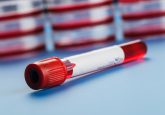Biomarker in breath could be used for early diagnosis of liver disease

A team from the University of Birmingham (UK) has discovered that limonene, a natural compound found in oranges and lemons, could be a potential biomarker for liver disease and may therefore be used for early-stage diagnosis. Previously discovered biomarkers for liver disease are unreliable since they are either non-specific or can arise due to normal metabolic processes. The team’s research was recently published in EBioMedicine.
Individuals with liver disease often do not present symptoms until the disease is advanced. Even at this stage diagnosis is challenging, as symptoms and signs are often general and can therefore be mistaken for other pathologies. This difficulty of diagnosis is a problem because advanced cirrhosis can only be treated via a liver transplant.
The team’s study was carried out in two phases: initially, breath samples from a group of 31 individuals suffering from cirrhosis were compared with a healthy control group; then samples from pre-transplant liver disease sufferers were compared with a sub-cohort of 11 individuals who had undergone a liver transplant.
The research group found that the levels of limonene in the breath of those suffering from cirrhosis were high when compared to healthy individuals. This is due to cirrhosis sufferers being unable to fully metabolize limonene. In the sub-cohort of individuals who underwent a liver transplant, it was found that limonene levels gradually dropped over several days, after the transplant. This led the team to hypothesize that unmetabolized limonene had been stored in the body fat of those suffering from cirrhosis.
The samples were collected using a protocol developed by Raquel Fernandez del Rio (University of Birmingham), and analyzed using mass spectrometry.
The use of a breath sample to detect liver disease is advantageous as it is non-invasive. In addition, a breath analyzer could be developed allowing for point-of-care detection of the disease. Margaret O’Hara (University of Birmingham), primary investigator on the project, commented: “If our further research is successful, in the future we can envisage a small portable breath analyzer that can be used by GPs and other health professionals to screen for early-stage liver disease , leading to earlier treatment and better survival rates.”
The team is now seeking additional funding to continue the research program to evaluate the diagnostic accuracy of breath volatile analysis for early-stage cirrhosis.
Sources: New breath test shows possible biomarker for early-stage liver disease diagnosis; del Rio RF, O’Hara ME, Holt A et al. Volatile biomarkers in breath associated with liver cirrhosis – comparisons of pre- and post-liver transplant breath samples. EBioMedicine (doi:http://dx.doi.org/10.1016/j.ebiom.2015.07.027) (2015) (Epub ahead of print).





